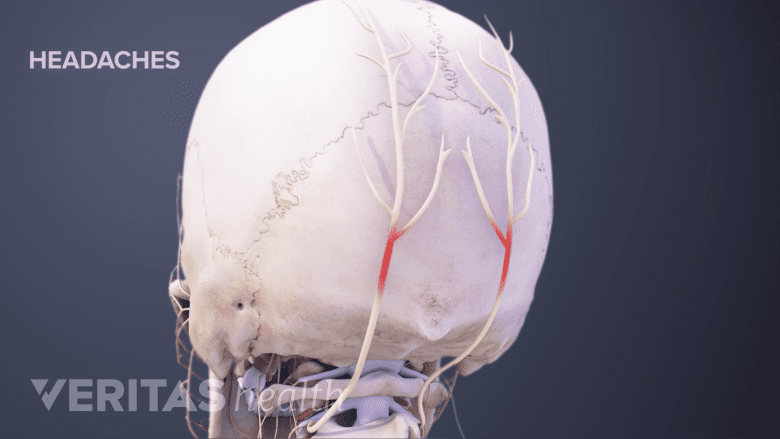Meningitis is a serious condition that occurs when the meninges—protective membranes covering the brain and spinal cord—become infected and inflamed. Early symptoms can be similar to the flu. However, having a stiff neck in addition to flu-like symptoms could be a key clue that meningitis is the problem and should be checked by a doctor.
There are several types of meningitis, but this article focuses on the two most common ones: viral and bacterial. In cases where someone has contracted bacterial meningitis, finding medical attention immediately (within a few hours of initial symptoms) can be the difference between making a full recovery and permanent disability or death.
In This Article:
- When Neck Stiffness May Mean Meningitis
- How Meningitis Causes Neck Pain and Stiffness
- Stiff Neck Symptoms and Causes Animation
Common Symptoms
Headache with neck stiffness is a common symptom of meningitis.
Meningitis can start suddenly, and early symptoms may include one or more of the following:
- Fever. Running a fever is a common part of the immune system’s defense against infections. A fever with meningitis will usually be above 103 degrees, but not always.
- Headache. A headache caused by meningitis is typically described as severe and unrelenting. It does not subside by taking an aspirin.
- Stiff neck. This symptom most commonly involves a reduced ability to flex the neck forward, also called nuchal rigidity. Depending on the severity of the nuchal rigidity, the neck might be able to flex about half of what it could do before, or it might hardly flex at all.
As time goes on, other symptoms can develop, such as nausea, vomiting, sensitivity to light or noises, cognitive problems with concentration and memory, and many other latter-stage symptoms.
In addition, it should be noted that bacterial and viral meningitis are both contagious, so they are more likely to be contracted and spread in areas where people live in close quarters, such as college dorms or military barracks.
Meningitis Diagnosis
Diagnosing meningitis is difficult and requires the insight of a medical professional. If meningitis is suspected based on the patient history and physical exam, diagnostic tests will need to be done. These tests could include one or more of the following:
Spinal tap
A spinal tap involves inserting a needle into the lower spine to draw cerebrospinal fluid.
A spinal tap, also called a lumbar puncture, involves inserting a needle into the spinal canal in the lower back (a safe distance beneath the spinal cord) and drawing a sample of cerebrospinal fluid. Numerous lab tests will be run on the cerebrospinal fluid, such as to measure glucose, protein, red and white blood cell counts, and to determine which specific bacteria, virus, or other microorganisms might be present. The spinal tap and its associated tests are critical to achieving an official meningitis diagnosis.
Blood tests
Before the spinal tap, typically blood tests will be done for a quick analysis to look for inflammatory markers suggestive of an infection or other illness. In some cases, a blood test could indicate meningitis is unlikely, preventing the need for the patient to undergo an invasive spinal tap.
Imaging study
A CT scan or MRI scan of the brain is usually done before the spinal tap, especially if symptoms include any neurological deficits such as confusion or light sensitivity. An imaging study may show brain swelling and whether it is safe for a spinal tap to be performed. If it is determined that a change in cerebrospinal fluid (CSF) pressure from a spinal tap could cause the brain to herniate and move downward, the procedure will need to be delayed until the pressure on the brain is reduced.
The spinal tap’s lab results for potential bacterial or viral cultures can take a few days for enough growth to be analyzed, which is why an official meningitis diagnosis cannot typically be made the same day. However, faster tests are being researched and may be available in the future. 1
Treatment for Meningitis
Minutes matter when it comes to treating bacterial meningitis. As such, doctors cannot wait several hours or days to see if a lab test comes back positive for bacterial meningitis. If meningitis is suspected and cannot be ruled out by the initial examination, doctors will usually start treating the patient with a broad-spectrum antibiotic to prevent any potential bacterial meningitis from growing out of control.
After the test results come back, the doctor will know if meningitis is the official diagnosis, as well as what type. For viral meningitis, there is typically no specific treatment aside from getting rest and trying to maintain a healthy intake of fluids and nutrition. For bacterial meningitis, the broad-spectrum antibiotic will be replaced by an antibiotic that targets the specific bacteria causing the meningitis.
See 2 Neck Pain Symptoms That Require Immediate Medical Attention
Depending on the patient and severity of the meningitis, other medications may also be used.







